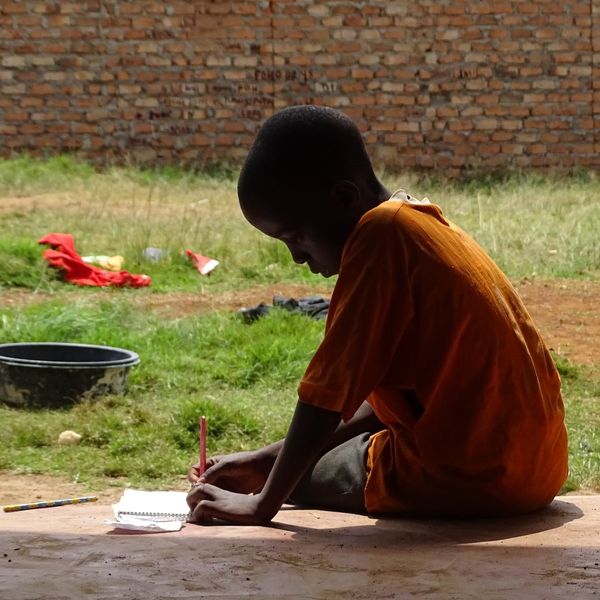Editor’s note: This is part 2 of a 2-part series, “Tracking down a poison.” See part 1 here.
NEW YORK CITY — A third of the world’s children have so much lead in their blood they’re poisoned. These children experience cognitive and behavioral delays, reduced kidney function, anemia and more. They might drink water that passes through old pipes, play with toys decorated with lead paint, eat food served on contaminated dishes or walk past an informal lead-acid battery recycling facility on their way to school.
The sources of this mass-poisoning are widespread, with countless industries and products subtly introducing lead into people’s lives. The impacts of lead are felt most by those in low- and middle-income countries, which often lack the resources to identify and prevent lead-poisoning. The world took one major step forward by banning leaded gasoline in cars in all countries as of 2021. Yet, environmental health experts say lead poisoning remains an overlooked global health crisis. They’re working to bring the impacts of lead into the light and prevent exposure, one country and one source at a time.
Lead — an overlooked poison

No amount of lead exposure is safe, many health authorities agree. For children, lead exposure can be particularly devastating: it decreases IQ points, delays development and creates behavioral challenges, among other symptoms. Adults can experience problems with kidney function, anemia, the cardiovascular system and more. The severity of symptoms increases with higher exposure, but recent research shows that even a small exposure can impact health, according to the United Nations Children’s Fund (UNICEF).
Despite its severe impacts, it’s difficult for doctors in low- and middle-income countries to diagnose a lead poisoning case, Abheet Solomon, global program lead of healthy environments for healthy children at UNICEF, told EHN (EHN). He compares lead to the wildfire smoke that descended on UNICEF’s headquarters in New York this summer, “everybody saw the air pollution…you can’t say the same thing about lead because lead is invisible.”
The symptoms of lead poisoning are also subtle. While wildfire smoke might make someone cough the same day, lead operates on a longer timeline, and causes less obvious symptoms like IQ deficits or growth delays. “It’s hard to say this is a child that’s been poisoned by lead until you test,” Solomon explained.
In high-income countries blood lead tests are more common. In the U.S., most states require or recommend that children have blood lead tests between 12 and 24 months. Young children in the U.S. had a median blood lead level of 0.6 micrograms per decilitre from 2017-2018, according to the latest Environmental Protection Agency data. That’s well below the five micrograms per decilitre threshold for lead-poisoning, estimated in one in three children around the world (although pockets of significant lead exposure still occur in the U.S., such as in Flint, Michigan, where about 5% of children had lead poisoning due to lead water pipes in 2015.)
The barriers to sufficient testing in developing countries are numerous. First is a knowledge gap, “there’s little awareness in low- and middle-income countries about how pollution damages children’s health,” said Solomon. He explained that there’s better international awareness and resources for infectious and non-communicable diseases.
Then there are resource and technology limitations. Few low- and middle-income countries have the lab capacity needed to monitor blood lead levels. As of 2019, studies of blood lead levels had only occurred in 44 out of 137 low- and middle-income countries.

For the data that do exist, the global inequality is stark. One study found mean children’s blood lead levels well-above the five microgram per decilitre measure for lead-poisoning in low- and middle-income areas including Palestine, Pakistan, Cameroon and Egypt, among others.
UNICEF is gearing up to change this, Solomon said. Working with governments, they facilitate a survey of children’s health in developing countries about every 10 years, called a multiple indicator cluster survey (MICS). In 2018, Georgia became the first country to add blood lead testing to their MICS, after a small study of children’s blood lead levels indicated there could be a national problem. It was an important step for Georgia to get a national picture of lead-poisoning, Dr. Ziad Kazzi, a medical toxicologist and emergency medicine professor at Emory University who led the initial blood lead study, told EHN. “They don’t typically do environmental health assessments [on the MICS],” he explained. That year’s MICS revealed that 41% of children in the country had lead-poisoning, compared to 2% in the U.S., according to the Centers for Disease Control. Lead-contaminated spices were found to be a significant contributor to the poisonings.
That finding triggered better regulation, and there are some early signs that children’s blood lead levels could be dropping as a result. “I'm always hoping that other countries will pursue [blood lead testing] with their UNICEF office,” Kazzi said, and he’s eager to see more comprehensive follow-up data in Georgia.
Now, Solomon is working through UNICEF to get testing for lead and other harmful heavy metals on the MICS in more countries. “We have two countries lined up and we plan to do it in 10 countries over the next four years,” he reported, declining to name the two countries.
Finding a lead-poisoning culprit


In 2018, Georgia became the first country to add blood lead testing to their multiple indicator cluster survey (MICS).
Credit: Pure Earth
Once lead poisoning is identified in a child, it can be difficult to track down the source. In the U.S., some city and state programs take on this task. In New York City, the Department of Health and Mental Hygiene receives the blood lead levels of every New Yorker tested, and investigates each case of poisoning to find and remove the source.
Their consumer products database tracks years of investigations that identified lead-contaminated items like kohl eyeliner, metal amulets, painted dishes, cooking vessels, spices and medicines, typically purchased abroad.
When patterns emerge, the department issues warnings to communities. They also go incognito in stores to purchase and test items that might contain lead. “If we have identified a certain type of product that keeps showing up amongst our cases, we want to find out if it's available in New York City stores,” Paromita Hore, director of environmental exposure assessment and education at the New York City Department of Health and Mental Hygiene, told EHN.
If they find stores selling the products they can take enforcement actions. But most often, the products causing lead poisoning are carried by individuals back to New York from countries with weaker regulation and enforcement.
“If one country has a problem, the impact of that problem is not constrained to their borders,” Andrew McCartor, executive director of Pure Earth, a non-profit dedicated to reducing global lead and arsenic exposure, told EHN.
Hore’s department often reaches out to other countries’ consulates to alert them of an issue with a product, and she thinks those efforts could be expanded. “We could have a national repository…you can essentially scale up what we’re doing in New York City,” she said. Other areas, like North Carolina, conduct similar lead investigations. Coordinating those efforts could build a better picture of lead poisoning sources and inform action.
The kind of investigations needed to find the cause of a lead-poisoning case occur rarely around the world. McCartor’s organization, Pure Earth, is hoping to change that with a program to test blood lead levels in seven low- and middle-income countries and test consumer products that might contain lead in 25 countries. They’re building the data that can show governments where to act to reduce lead-poisoning. And there’s precedent for global action on lead — just two years ago leaded gasoline was phased out from cars in every country on Earth.
The world gets lead out of gasoline
In August 2021, the last tank of leaded gas going into a commercial vehicle was pumped in Algeria. This exhausted their supply, and made it the final country in the world to phase out the toxic fuel from cars. Leaded gasoline came on the market a century earlier promising to help engines run smoother, but emitting dangerous fumes in the process. Public health experts raised concerns as early as the 1920s, but the gasoline remained on the market for a century, emitting nearly 10 million tons of lead into the Earth’s environment, a portion of it ending up in people’s bodies.
Japan became the first country to completely phase out leaded gasoline in 1986, with the U.S. following in 1995, finishing a process started by the Environmental Protection Agency two decades earlier. Between 1976 and 1991 the average blood lead level of a person in the U.S. dropped from 12.8 micrograms per decilitre – well above the 5 microgram per decilitre measure for lead poisoning – to 2.8 micrograms per decilitre. Leaded gasoline is still used in other vehicles like planes, farm equipment and race cars around the world. (In 2022, researchers found that students living near a race track in Florida scored 4.4% lower on a state standardized test until NASCAR voluntarily phased out leaded gasoline in 2007.)
Throughout the 2000s, countries around the world followed, spurred by a United Nations campaign to phase out leaded gasoline globally. When they started, 117 countries still used leaded gasoline, including nearly all countries in sub-Saharan Africa. Attention and resources from the UN campaign helped phase out the toxic gas in most African countries within just a few years, said Jane Akumu of the UN Sustainable Mobility Unit in a webinar. She explained that collecting data on lead pollution and blood lead levels before and after the phase out in some countries helped convince others to act. Many of the countries that took longer to phase out the gasoline had political conflicts that made policy changes difficult to implement, she said.
When Algeria used the last of its supply in August 2021, they ended a century of toxic pollution. This achievement represents “a testament to the power of multilateralism to move the world towards sustainability and a cleaner, greener future,” Inger Anderson, executive director of the UN Environment Program, said at the time.
Two of the largest causes of global lead-poisoning today are lead-based paints and informal lead-acid battery recycling centers. Lead can be added to paint for color or corrosion control in homes or products and ingested by young children when it chips. The UN is currently working to help all countries regulate and enforce bans on lead in paint, which 48% of countries have done, according to the World Health Organization.
Use of affordable lead-acid batteries is increasing as the world electrifies, exposing many to lead. The batteries can be effectively recycled, but informal recycling centers without sufficient health and safety precautions create health risks for workers and surrounding communities. The UN and other NGOs working on this issue aim to build knowledge, regulations and enforcement capacity to promote safe lead-acid battery recycling.
Beyond paints and batteries, countless products create less obvious lead exposures. These are the sources that require more investigative resources to track down.
Who’s left behind when it comes to lead exposure?

“It’s kind of a backwards approach. We’re basically using kids as canaries in the coal mine."
Credit: Pure Earth
Removing a source of lead poisoning can stop symptoms from progressing, but the neurological and developmental delays it causes can’t be undone. “You’ll find sometimes the environmental toxicology side doesn’t connect to the clinical side,” said Kazzi, of Emory University. “What about the people that have the lead in their body? Who’s going to take care of them?”
As a medical toxicologist, he emphasizes providing care to those affected by lead poisoning concurrently with finding and removing exposure sources. That means improving nutrition, which can help reduce absorption of lead still present in blood, and providing support for children with learning and development disabilities. Not all children with lead-poisoning will experience a learning disability, but its negative impacts on IQ and development can push more kids into that category.
When countries add blood lead tests to their MICS, equipping governments to address the problem is key, said Solomon of UNICEF. Each country’s government has control over the MICS and they choose what data to share. An action plan to address lead poisoning encourages data transparency, he explained.
“We need to be building the response plan with the survey itself,” said Solomon, “[countries] need to be seen to be taking action to actually address these issues.” They took this approach in Georgia, so that when high lead-poisoning was found the government quickly rolled out treatment and exposure prevention plans.
Many working in the field worry about the ongoing exposures people face as they race to develop the data and resources they need to take action.
“It’s kind of a backwards approach. We’re basically using kids as canaries in the coal mine,” Ed Norman, program manager of childhood lead-poisoning prevention at the North Carolina Department of Health and Human Services, told EHN. His program often identifies homes with lead paint as a source of childhood lead poisoning, along with products like ceramics, spices, toys and bullets. “We’re testing the kids to see if there’s an exposure we should be preventing…in that sense it’s kind of sad, but we are able to prevent exposures for future generations of kids.”
- Toxic exposures may cost the world 10% of GDP: Study ›
- How contaminated water contributes to mental illness ›
- Lead in hunted meat: Who’s telling hunters and their families? ›
- Protecting California’s children and communities from leaded aviation fuel pollution - EHN ›


























